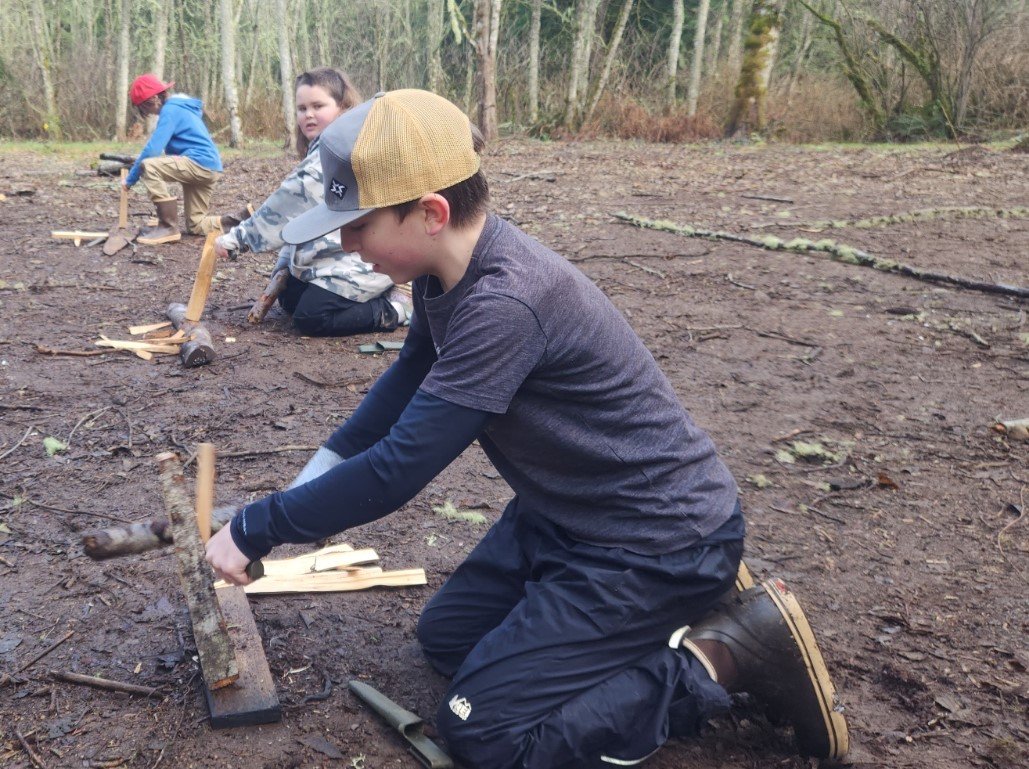Kids and knives: Knife Safety Policy for Carving and Whittling Activities for Kids
At Rainwalk Rewild, we believe that learning wilderness skills is more than just a hobby—it's a gateway to connecting with nature and fostering self-reliance. One of the fundamental skills we teach is knife carving, a practice that's been around since our ancestors first sharpened stones. But before our young adventurers can start whittling their way to wooden masterpieces, they need to earn their knife safety certifications. Safety and respect are at the core of everything we do, and when it comes to handling sharp tools, these values are non-negotiable.
Why Knife Carving Skills Are Essential to Learning Wilderness Skills
Knife carving isn’t just about making pointy sticks (although that’s pretty fun too). It's a skill that builds hand-eye coordination, patience, and creativity. Historically, knives were essential for survival, used for everything from preparing food to crafting tools and building shelters. Learning to carve is like stepping back in time and connecting with the primal roots of human ingenuity.
Carving also teaches patience and mindfulness. As any seasoned carver will tell you, rushing leads to mistakes (and occasionally band-aids). Plus, it’s a fantastic way to improve focus and dexterity, skills that are valuable both in the wilderness and everyday life.
Appropriate Knives for Carving
Choosing the right knife for carving is crucial. Not all knives are created equal, and some are better suited for little hands and big imaginations. Here are our top picks:
Fixed-blade knives: These are sturdy and reliable, making them great for beginners. Look for a blade that's around 3-4 inches long. This is our preferred style of knife for bushcraft and carving skills.
Folding knives: While convenient for their compact size, ensure they have a locking mechanism to prevent accidental closures. Swiss Army Knives and Leathermans are nice multi-tools but they are not recommended for carving.
Features to look for include a comfortable handle (rubber or wood are great choices), a sharp blade (a dull knife is more dangerous than a sharp one), and a safe sheath for storage.
Recommended Models:
Morakniv Companion: A durable, inexpensive, easy-to-handle fixed-blade knife useful for bushcraft and carving.
This one is our top choice for beginners, wilderness survival enthusiasts, and everyday carvers.
The link above is an Amazon affiliate link, which gives us a small percentage of the sale and allows us to help students find quality products without having to keep them in stock ourselves.
Beavercraft Tools: This company produces a wide range of excellent knives for bushcraft, whittling, and spoon carving.
If you are looking for more variety of carving tools or a higher quality whittling knife, we might steer you this direction.
Opinel No. 7 Scout Knife: A folding knife designed specifically for young carvers, complete with a rounded tip and safety ring.
Not our favorite option, but a good one for families with enthusiastic young carvers that want a safer, compact folding knife.
Training Students to Use Knives Safely
Our knife safety certification process is thorough and hands-on, ensuring that every student knows how to handle their tools with care.
Initial Safety Briefing: We start with the basics, emphasizing the importance of respecting the knife as a tool, not a toy.
Knife Carving Demonstration: Our experienced instructors show proper knife handling techniques, from safe gripping to effective carving strokes.
Hands-on Carving Practice: Students get to practice under close supervision, starting with simple cuts and progressing to more complex projects.
Assessments: Practical tests ensure that students understand and can apply safety principles.
Knife Safety Rules
First and foremost, knives are tools and not weapons. Any brandishing of a knife as if it were a weapon or threats against self or others will end carving activities for that student. Threats of violence is cause for an immediate conversation with the parent including an early termination of their class day, likely suspension from the camp or course, and may lead to expulsion from all Rainwalk Rewild programs.
Our golden rules of knife safety are simple but essential:
Ask permission from an instructor before unsheathing your knife.
This step includes showing off your new knife to other students or slicing an avocado. We want to make sure instructors know that knives are out so they can hold a safe container for all students. There are certain times carving might not be the best idea: i.e. during games or instruction.
Find a safe place and position for carving.
A “blood circle” or “blood bubble” maintains arm width plus stick distance from other students.
If someone accidentally enters your blood circle, pause carving.
If you are entering someone’s blood circle, announce yourself and ask permission.
Carving should not take place in the middle of a trail or activity area.
Carvers should be within sight of an instructor at all times.
Wear Kevlar or leather carving gloves.
These gloves help prevent slices but not punctures. Even advanced woodworkers wear gloves to prevent accidents!
Unsheathe your knife carefully and hold it using the proper grips.
A knife is not a sword!
We use “crab claw” grips on the sheath when sheathing and unsheathing the knife.
The knife and carving project (stick) is usually held with an “ice cream cone” grip.
Some variations may occur due to different/advanced carving techniques.
Always carve way from your body AKA “body behind the blade”.
Carving and whittling should be slow and controlled.
Understand the importance of keeping carving motions out of your “danger triangle”.
Utilize proper hand grips and carving motions to avoid slicing appendages.
Keep your eyes on the blade.
If a classmate is telling a captivating story or joke, stay focused on your carving project. If this is not possible, pause or stop carving. You can politely remind classmates that you are trying to pay attention to your project or move if necessary.
If your focus is shifting away from carving, sheathe your knife and take a break!
Sheathe your knife whenever you stop carving.
Look down the sheath to ensure your blade is going into the right place. When using a Morakniv, there should be a “click” when the knife is inserted properly into its sheath.
If you need to gather more materials or move before returning to carving, sheath your knife and leave it at your carving station or carry it with you if necessary.
If you are no longer going to carve, sheathe your knife and put it away into your backpack or the class knife bag.
“Stop” means STOP.
Sometimes an instructor or another classmate might ask you to stop carving. If they do, stop immediately and sheathe your knife.
What Happens If They Break a Rule
Safety is our top priority, and we take knife carving seriously to ensure everyone stays safe.
Here’s what happens if a student breaks a rule:
Verbal Warnings: For minor infractions, a gentle reminder of the rules.
Temporary Suspension: For more serious or repeated breaches, students may lose knife privileges for a time.
Additional Training: If needed, students will undergo further safety training to reinforce the importance of the rules.
Maintaining a safe environment is essential for everyone to enjoy and learn effectively. Following the rules not only prevents accidents but also helps build a community of trust and respect.
Knife carving is a fantastic way for kids to develop important wilderness skills, but it must be done safely and respectfully. At Rainwalk Rewild, we are committed to teaching these skills within a framework of safety and responsibility. We encourage parents and guardians to support their children on this journey and to reinforce the importance of our safety rules at home.
If you’re ready to carve out some memories with us, learn more about our programs and how we can help you reconnect with the rhythms and wisdom of the earth.
Check out our upcoming Youth Programs or Field Courses to begin or continue your rewilding journey.
Happy carving, and stay safe out there!



